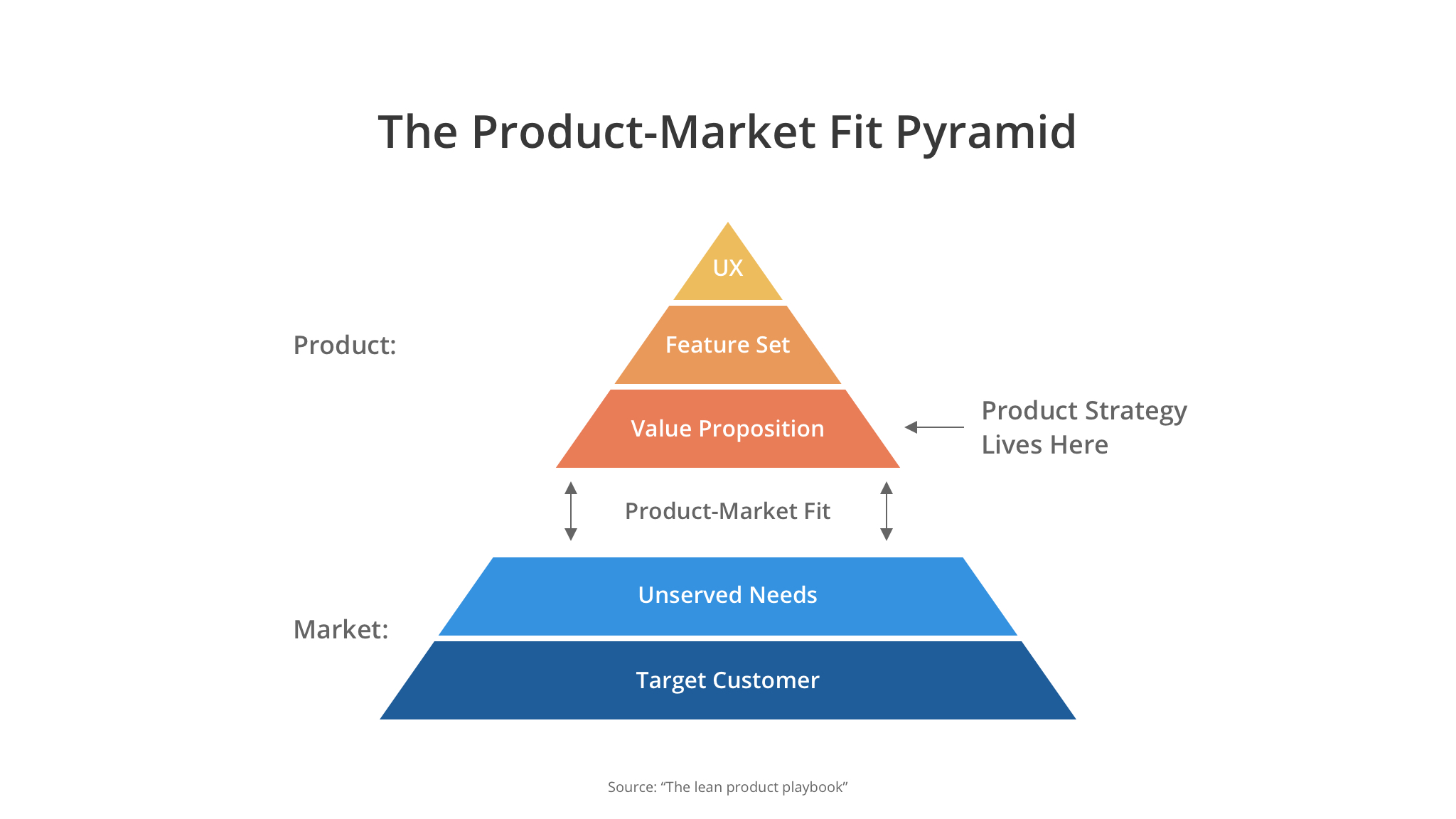Having a good product strategy is a must for achieving a successful product in the long term, but it’s hard to get. The main reason is because there isn’t a framework for doing so.
A good plan is rarely enough. When you build a house, you typically have a blueprint to follow. This is your plan, your roadmap, your set of to-dos. But what happens when you run into trouble? In the case of a house, this could be an unexpected physical obstacle, a change in material prices, or simply a customer who wants to add a window. What happens when you need to adapt your blueprint? How do you make decisions when conditions are ever-changing and uncertain?
That’s when you need a strategy, of course! Your plan is your blueprint; your strategy is your vision for success.
In the Product Design world, a product strategy is essential for long-term success. As we’ve mentioned, this is not a plan or a set of actions to take. It’s a vision. For product development teams, defining a blueprint is usually accomplished, but creating a product strategy is often not.
We use our discovery phase to help companies understand and design their product strategy during early stages of the software development process.
Let’s take a closer look at what a product strategy is and how we approach it to create long-term value for our clients.
“Set a product strategy to determine the direction of your product efforts.”
Wow, that title sounds good right? But if product strategy isn’t a set of goals or a to-do list, what is it? Where does it fit? How should you craft it? What do you need to consider? And most importantly, once you get your strategy, how do you use it? Those are all great questions. Let’s give a brief overview and share some tips on how to approach this.
Starting from the beginning, your strategy is your vision to succeed. It’s what will help your product win in the long term. Let’s take those last two words and work through them.
Long term is how we should think while defining a product strategy. Remember, we are not talking about a set of features to solve a specific need or to make an exciting feature become reality. We are talking about a vision to succeed. Something meant to be used in the long term can’t be crafted based on short term goals. Here, we think years ahead, not months or quarters.
If we are thinking in the long term, we need to also think about big-picture items. There is a very good example about this mindset, from the book “7 Habits of Highly Effective People,” specifically the Large rocks vs. Sand example, which illustrates clearly what we are talking about here. The rocks are the big and most important items for our product in the long term, the sand is those specific and short-term items and then the pebbles are what’s in the middle. If you prioritize the sand over the big rocks, there will be no room for the important items in your jar. If you put in the big rocks first, then the pebbles and then the sand, everything fits perfectly. Here is a quick image of the concept.
There is no way for us to plan the details of a set of features (sand and pebbles) that we are going to implement 10 years from now, but we can know the main problem we are solving and the main value our product or service delivers to the customers (rocks).
Let’s review a quick example, Uber solves a very specific problem by helping people move from point A to point B. I know, there are many great features that also add value to the service that they provide like instant booking, realtime tracking, easy payment methods, feedback etc., which is how Uber differentiates themselves from a taxi cab for instance. Now, their service could be cars, it could be scooters, it could be helicopters or even planes in the future. You can order your ride through the app or voice command, but the underlying value, the problem or need they are solving for their customers, will always be to move people from point A to point B. Can you identify the big rocks and the sand and pebbles here? Yes? Great!
So far we have two important tips: thinking in the long term and thinking big picture.
Where does it fit? Where is my product strategy?
This is the “Product Market Fit” pyramid. It will help us better understand where your product strategy fits and why. I think this is a good example to quickly represent where your product strategy fits in your business.
There is a division in things you have control over (Product) and things that you don’t have control over (Market).
When you combine a group of people with a group of underserved needs, you essentially get a Market. The Market is basically a set or group of people that shares a common need.
Now let’s talk about the product, which has three main components. Let’s go from the bottom to the top:
- Value proposition: This basically indicates how your product will deliver the value that the customer wants to solve their needs and how it is different from the rest of the products out there. If you are doing things right, it will be built based on needs.
- Feature Set: These are the functionalities or set of features that are going to convey those customer benefits.
- UX: This defines how UX brings functionality to the life of users.
- Product Market Fit: It basically determines how well all the decisions, assumptions and implementation of the top 3 layers resonates with the market.
How are we going to be better? How are we going to meet those customers’ needs in a way that is better and different than others? Your product strategy. It’s right up there with your value proposition.
Your strategy must be focus on your customer needs
There is a famous quote about a hole. Yes, a simple hole. It says “People don’t want a quarter-inch drill, they want a quarter-inch hole.” The drill is the solution, the hole is the problem.
Usually backlogs and product plans are based on features or functionalities, but it is always important to keep the benefits and not the features in mind while making decisions. Remember the Uber example? It could be a car or a helicopter, the benefit is moving from point A to point B. That is the actual problem or need you are trying to address.
Why are we talking about this? Well, product strategy in practice helps you make those essential choices in unexpected circumstances. When you need to prioritize areas, you’ll look towards your product strategy to guide you. Defining your values is a key part of understanding your product strategy. Think about what the customer problem is you are trying to solve and how you want to add value.
User research is a way for you to find out what values are essential to your end-users. Instead of you guessing and getting it wrong, it’s best to ask users or people in the market that are not your users yet. They’ll give you a better sense of those essential values that should guide your product development.
Always ask about needs and not about solutions. You are the one determining the solutions to their problems or needs based on your value proposition, your feature set and your UX, using your product strategy. Otherwise, everyone would be a product manager.
Your product strategy should always be working towards solving these problems. And the values you identify are glimpses into what a world without this problem would look like. If you don’t make a product that meets users’ needs, you’ve done something wrong. Your product strategy has failed, or perhaps it was simply absent.
Think about benefits not features
When you are defining your strategy, you should always think about benefits and not features. This translates directly into the problem space (User Benefit) vs. the solution space (Product or Service).
Stay in the problem space while defining your strategy. Here you need to flush out all the benefits the user will have while using your product. These are written with the same pattern.Here are some suggestions:
- Written from the voice of the user
- Always starts with a verb, because they do something for the user. Going back to the Uber example: “Transport me from point A to point B.”
After you define your problem space, you should identify which ones you will tackle and be the best at to differentiate your product from the rest of the competition. The Kano model could be a good method to perform this. This is a huge topic that could have it’s own blog post, so let’s keep it short, but make sure you check out the Kano Model .
The output of the Kano model analysis will basically be the foundation for your product strategy, the big rocks. In other words, your vision for a successful product in the long term.
Make good use of your product strategy
Ok, I have my product strategy, so now what?. The only thing left is to make good use of it. Always keep it in mind while making decisions and planning features. You should always validate and review your product strategy from time to time and make sure it is still aligned with the real problem you are solving for customers.
Make sure your strategy is not in a vacuum. You should always be informed by competitor analysis and feed that information into your product strategy to make it better and stronger.
It’s very easy to forget about the product strategy sometimes, especially when it comes to revenue.
Have you been in a situation where you use a tool for free and suddenly it becomes a paid tool? If they are not delivering more value out of that extra cost, then they are probably solving a company’s issue, forgetting completely about the product strategy. This is a common mistake: meeting revenue goals is a company problem, not a user problem.
Quick recap
So now you have a good foundation. Think in the long term and on big-picture items. Make sure that your Product strategy is aligned with your value proposition, your feature set and your UX to fit the market needs you are targeting. Think always about benefits, not features when you are ideating (the problem space vs. the solution space). Keep your product strategy outside a vacuum and make sure you validate it from time to time. Use it when a big decision needs to be made, especially those that will affect your product or service in the long run. In this way, you will be right on track for achieving a successful product in the long run.
Conclusion
At Making Sense, we believe the mindset of a product strategy is how we meet users’ needs. It’s how we solve a problem they have and create a product that fulfills these values. Though product strategy might seem hard to pin down, you can think of it as answers to these questions.
It takes us time to consider the values and vision for a product, but it ultimately saves us time and money, improves the value we provide to our customers and highlights our competitive differentiators. That’s because we create a product strategy and have that foundation to start building for success.


